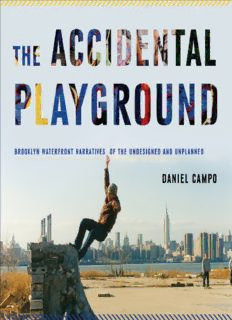
The accidental playground : Brooklyn waterfront narratives of the undesigned and unplanned PDF
Preview The accidental playground : Brooklyn waterfront narratives of the undesigned and unplanned
THE ACCIDENTAL PLAYGROUND THE ACCIDENTAL PLAYGROUND BROOKLYN WATERFRONT NARRATIVES OF THE UNDESIGNED AND UNPLANNED DANIEL CAMPO Copyright © 2013 Daniel Campo All rights reserved. No part of this publication may be reproduced, stored in a retrieval system, or transmitted in any form or by any means—electronic, mechanical, photocopy, recording, or any other—except for brief quotations in printed reviews, without the prior permission of the publisher. All photos by Daniel Campo unless indicated otherwise. Fordham University Press has no responsibility for the persistence or accuracy of URLs for external or third-party Internet websites referred to in this publication and does not guarantee that any content on such websites is, or will remain, accurate or appropriate. Fordham University Press also publishes its books in a variety of electronic formats. Some content that appears in print may not be available in electronic books. Library of Congress Cataloging-in-Publication Data Campo, Daniel. The accidental playground : Brooklyn waterfront narratives of the undesigned and unplanned / Daniel Campo. pages cm Summary: “With its detail, depth, compassion and vision Campo’s work makes an invaluable contribution to the growing literature on the unplanned and the undesigned spaces and activities in cities today. Highly illustrated and artfully researched, the book will draw readers into a unique space in one of New York City’s most popular boroughs”—Provided by publisher. Includes bibliographical references and index. ISBN 978-0-82325186-5 (pbk.) 1. Recreation—New York (State)—Brooklyn. 2. Communities—New York (State)—Brooklyn. 3. Waste lands—New York (State)—Brooklyn—Recreational use. 4. Waterfronts—New York (State)— Brooklyn—Recreational use. 5. Brooklyn Eastern District Terminal. I. Title. HT281.C36 2013 307.09747’23—dc23 2013016262 Printed in the United States of America 15 14 13 5 4 3 2 1 First edition First edition In loving memory of my mother, Seena Campo, and for my father, Vincent Campo CONTENTS Prologue 1 Discovering and Engaging a Vacated Waterfront 2 The Rise and Fall of Shantytown Skatepark 3 March and Burn: Practice, Performance, and Leisure without a Plan 4 Outside Art: Exploring Wildness and Reclamation at the Water’s Edge 5 Local Tales: Hanging Out and Observing Life on the Waterfront 6 Residential Life: Hardship and Resiliency on the Waterfront 7 Neighbors Against Garbage: Activism and Uneasy Alliances on the Waterfront 8 Unplanned Postscript: Dogs, Sunsets, Rock Bands, and the Governance of a Waterfront Park 9 Planning for the Unplanned Notes Acknowledgments Index Color photographs follow pages 70 and 150 Greenpoint and Williamsburg. (Map by Megan Griffith and Daniel Campo, 2013.) THE ACCIDENTAL PLAYGROUND The former Brooklyn Eastern District Terminal and Northside waterfront. (Graphic by Megan Griffith using Google Earth satellite images.) PROLOGUE ON JUNE 13, 2000, New York Governor George Pataki announced that the state had agreed to purchase seven acres of waterfront property in the Williamsburg section of Brooklyn, where it would build New York’s 160th state park. With its stunning views of midtown Manhattan, the property was part of a vacant waterfront railroad yard on Williamsburg’s Northside known as the Brooklyn Eastern District Terminal or BEDT. Closed in 1983, the yard was for more than a century where freight cars were pulled off of and pushed onto barges, connecting Williamsburg factories, refineries, and warehouses with similar terminals on the New Jersey side of the harbor. With its tracks pulled up, freight houses demolished, and finger piers falling rapidly into the river, the decaying terminal was ripe for reclaiming. “By converting this underused site into a recreational opportunity for the community,” the governor proclaimed, “we are taking one more step toward re-connecting residents and visitors with one of New York State’s most important waterfront resources.”1 BEDT was long thought of as an ideal site for a park in a neighborhood starved for parks and waterfront access. Two years earlier, at the urging of Brooklyn State Assemblyman Joseph Lentol and a coalition of local advocacy groups, the governor had placed the terminal on the property acquisition list of the state’s Open Space Conservation Plan, which would make it eligible for purchase using the Environmental Protection Fund, a bond referendum approved by the voters of New York state in 1996. The governor had allocated $10 million from the fund for the terminal’s redevelopment, but purchase alone would cost $8.3 million, setting a record for a state parks land purchase on a per-acre basis and leaving little money for the planning, design, and construction of the park itself. But the governor had a solution. Behind the scenes, the Trust for Public Land, a national land conservancy group, had been working for two years with officials from the state Office of Parks, Recreation and Historic Preservation and Williamsburg advocates to identify a partner who could serve to defray the development costs and act as co-steward of the site. The Trust had connected these parties with New York University, which desperately sought a place to build practice and competition sports fields for its NCAA athletic teams. The north edge of the institution’s sprawling Manhattan campus was just three stops and a short walk to the waterfront via the L train
Description: